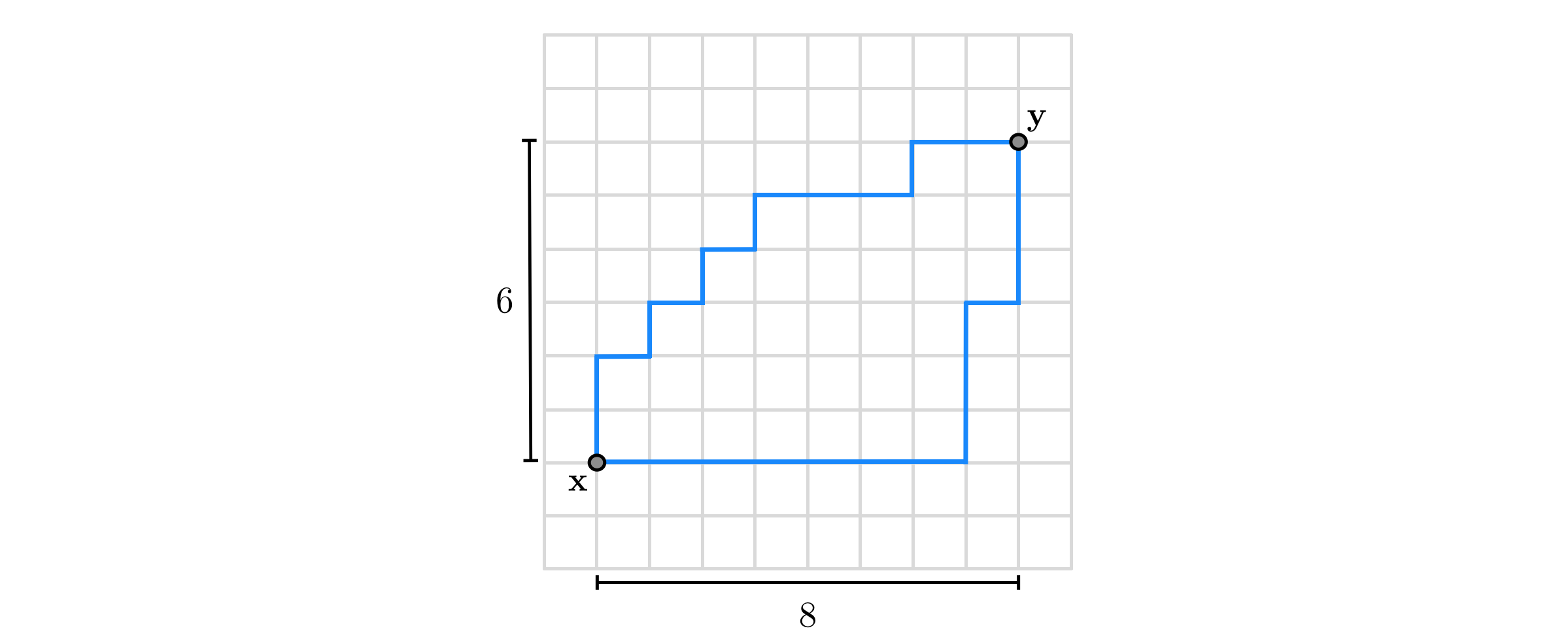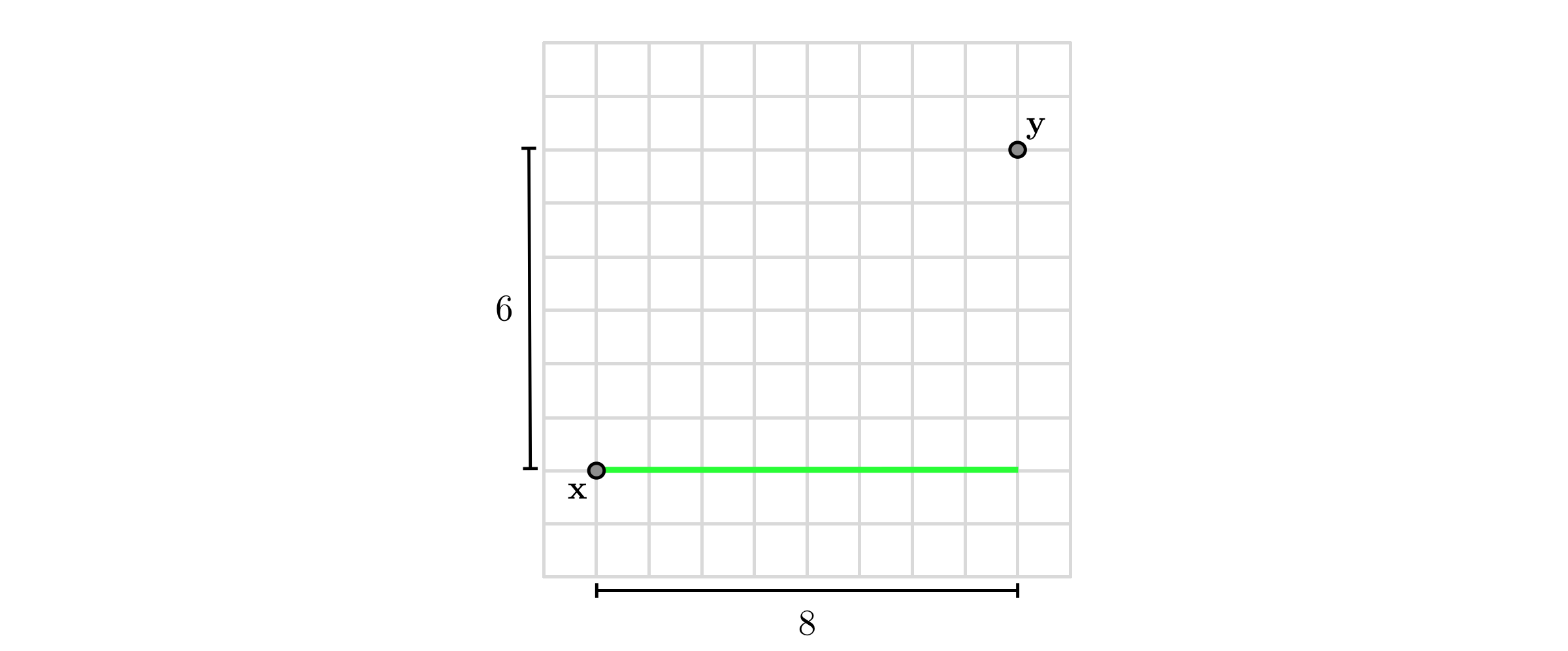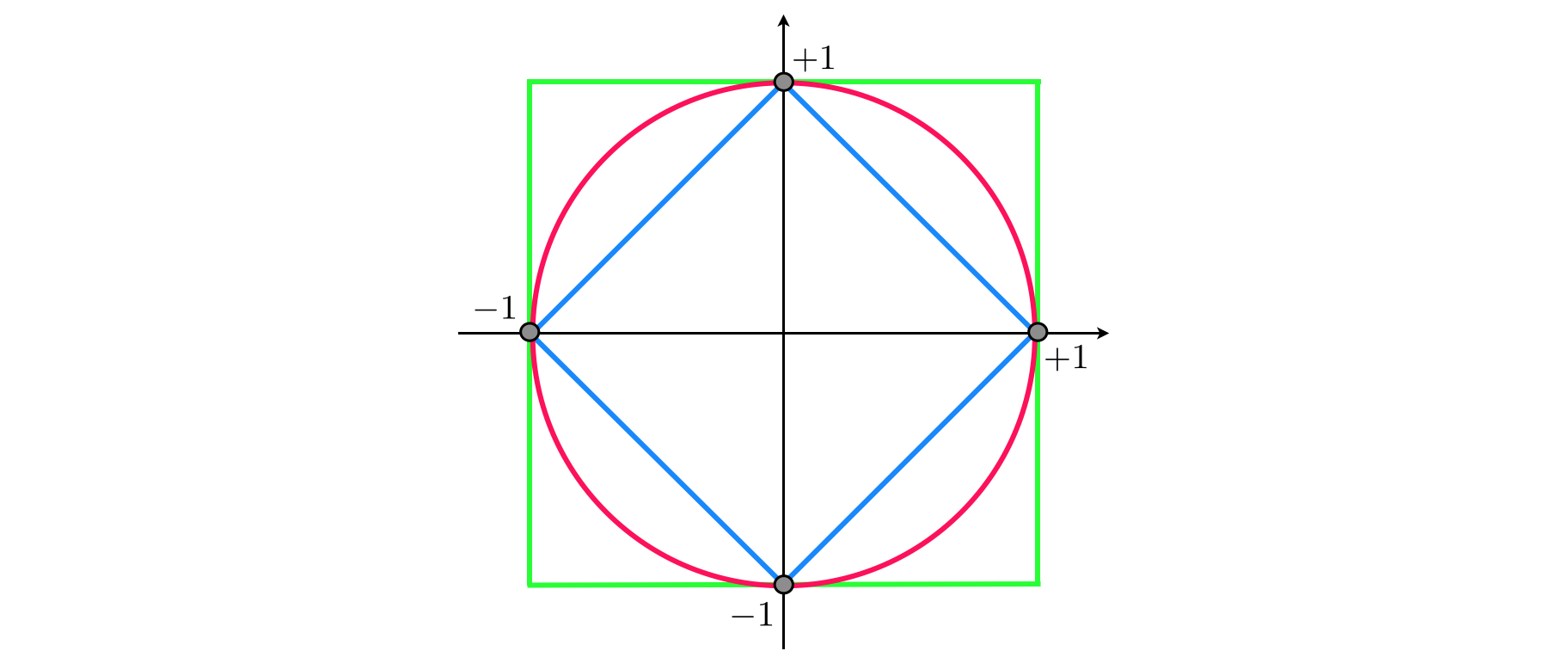In this post we discuss popular vector and matrix norms that will arise frequently in our study of machine learning and deep learning. A norm is a kind of function that measures the length of real vectors and matrices. The notion of length is extremely useful as it enables us to define distance - or similarity - between any two vectors (or matrices) living in the same space.
We begin with the most widely-used vector norm in machine learning, the $\ell_{2}$ norm, defined for an $N$ dimensional vector $\mathbf{x}$ as
\begin{equation} \left\Vert \mathbf{x}\right\Vert _{2}=\sqrt{\sum_{n=1}^{N} x_{n}^{2}} \end{equation}Using the $\ell_{2}$ norm we can measure the distance between any two points $\mathbf{x}$ and $\mathbf{y}$ via $\left\Vert \mathbf{x}-\mathbf{y}\right\Vert _{2}$, which is simply the length of the vector connecting $\mathbf{x}$ and $\mathbf{y}$.
For example, the distance between $\mathbf{x}=\left[\begin{array}{c} 1\\ 2 \end{array}\right]$ and $\mathbf{y}=\left[\begin{array}{c} 9\\ 8 \end{array}\right]$ is calculated as $\sqrt{\left(1-9\right)^{2}+\left(2-8\right)^{2}}=10$, as shown pictorially in the figure below (recall Pythagorean theorem).

The $\ell_{2}$ norm is not the only way to measure, or more precisely define, the length of a vector. There are other norms arising occasionally in machine learning that we discuss now.
The $\ell_{1}$ norm of a vector $\mathbf{x}$ is defined as the sum of the absolute values of its entries
\begin{equation} \Vert\mathbf{x}\Vert_{1}=\sum_{n=1}^{N}\left|x_{n}\right| \end{equation}In terms of the $\ell_{1}$ norm the distance between $\mathbf{x}$ and $\mathbf{y}$ is given by $\left\Vert \mathbf{x}-\mathbf{y}\right\Vert _{1}$, which provides a measurement of distance different from the $\ell_{2}$ norm. As illustrated in the figure below the distance defined by the $\ell_{1}$ norm is the length of a path consisting of perpendicular pieces (shown in blue). Because these paths are somewhat akin to how an automobile might travel from $\mathbf{x}$ to $\mathbf{y}$ if they were two locations in a gridded city, having to traverse perpendicular city blocks one after the other, the $\ell_{1}$ norm is sometimes referred to as the taxicab norm, and the distance measured via the $\ell_{1}$ norm, the Manhattan distance.

In the example above the distance between $\mathbf{x}=\left[\begin{array}{c} 1\\ 2 \end{array}\right]$ and $\mathbf{y}=\left[\begin{array}{c} 9\\ 8 \end{array}\right]$ using the $\ell_{1}$ norm is calculated as $\left|1-9\right|+\left|2-8\right|=14$.
The $\ell_{\infty}$ norm of a vector $\mathbf{x}$ is equal to its largest entry in terms of absolute value, defined mathematically as
\begin{equation} \Vert\mathbf{x}\Vert_{\infty}=\underset{n}{\text{max}}\left|x_{n}\right| \end{equation}For example, the distance between $\mathbf{x}=\left[\begin{array}{c} 1\\ 2 \end{array}\right]$ and $\mathbf{y}=\left[\begin{array}{c} 9\\ 8 \end{array}\right]$ in terms of the $\ell_{\infty}$ norm is found as $\text{max}\left(\left| 1-9\right|,\left|2-8\right|\right)=8$.

The $\ell_{2}$, $\ell_{1}$, and $\ell_{\infty}$ norms, by virtue of being vector norms, share a number of useful properties that we detail below. Since these properties hold in general for any norm, we momentarily drop the subscript and represent the norm of $\mathbf{x}$ simply by $\Vert\mathbf{x}\Vert$.

In addition to the general properties mentioned above and held by any norm, the $\ell_{2}$, $\ell_{1}$, and $\ell_{\infty}$ norms share a stronger bond that ties them together: they are all members of the $\ell_{p}$ norm family. The $\ell_{p}$ norm is generally defined as
\begin{equation} \left\Vert \mathbf{x}\right\Vert _{p}=\left(\sum_{n=1}^{N}\left|x_{n}\right|^{p}\right)^{\frac{1}{p}} \end{equation}for $p\geq1$. One can easily verify that with $p=1$, $p=2$, and as $p\longrightarrow\infty$, the $\ell_{p}$ norm reduces to the $\ell_{1}$, $\ell_{2}$, and $\ell_{\infty}$ norm respectively.
A norm ball is a set of all vectors $\mathbf{x}$ with same norm value, that is, all $\mathbf{x}$such that $\left\Vert \mathbf{x}\right\Vert =c$ for some constant $c>0$. When $c=1$, this set is called the unit norm ball, or simply the unit ball.
As you can see in the figure below, the $\ell_{1}$ unit ball takes the form of a diamond (in blue), whose equation is given by
\begin{equation} \left|x_{1}\right|+\left|x_{2}\right|=1 \end{equation}The $\ell_{2}$ unit ball is a circle (in red) defined by
\begin{equation} x_{1}^{2}+x_{2}^{2}=1 \end{equation}And finally as $p\longrightarrow\infty$ the unit ball approaches a square (in green) characterized by
\begin{equation} \text{max}\left(\left|x_{1}\right|,\left|x_{2}\right|\right)=1 \end{equation}
Recall that the $\ell_{2}$ norm of a vector is defined as the square root of the sum of the squares of its elements. The Frobenius norm is the intuitive extension of the $\ell_{2}$ norm for vectors to matrices, defined similarly as the square root of the sum of the squares of all the elements in the matrix. Thus, the Frobenius norm of an $N\times M$ dimensional matrix $\mathbf{X}$ is calculated as
\begin{equation} \left\Vert \mathbf{X}\right\Vert _{F}=\sqrt{\sum_{n=1}^{N}\sum_{m=1}^{M} x_{n,m}^{2}} \end{equation}For example, the Frobenius norm of the matrix $\mathbf{X}=\left[\begin{array}{cc} -1 & 2\\ 0 & 5 \end{array}\right]$ can be found as $\sqrt{\left(-1\right)^{2}+2^{2}+0^{2}+5^{2}}=\sqrt{30}$.
The connection between the $\ell_{2}$ norm and the Frobenius norm goes even deeper: collecting all singular values of $\mathbf{X}$ in the vector $\mathbf{s}$ (assuming $N\leq M$)
\begin{equation} \mathbf{s}=\left[\begin{array}{c} \sigma_{1}\\ \sigma_{2}\\ \vdots\\ \sigma_{N} \end{array}\right] \end{equation}The Frobenius norm of $\mathbf{X}$ can be shown to be equal to the $\ell_{2}$ norm of $\mathbf{s}$, i.e.,
\begin{equation} \left\Vert \mathbf{X}\right\Vert _{F}=\left\Vert \mathbf{s}\right\Vert _{2} \end{equation}The observation that the $\ell_{2}$ norm of the vector of singular values of a matrix is identical to its Frobenius norm motivates the use of other $\ell_{p}$ norms on the vector $\mathbf{s}$. In particular the $\ell_{1}$ norm of $\mathbf{s}$ defines the nuclear norm of $\mathbf{X}$ denoted by $\left\Vert \mathbf{X}\right\Vert _{*}$
\begin{equation} \left\Vert \mathbf{X}\right\Vert _{*}=\left\Vert \mathbf{s}\right\Vert _{1} \end{equation}and the $\ell_{\infty}$ norm of $\mathbf{s}$ defines the spectral norm of $\mathbf{X}$, denoted by $\left\Vert \mathbf{X}\right\Vert _{2}$
\begin{equation} \left\Vert \mathbf{X}\right\Vert _{2}=\left\Vert \mathbf{s}\right\Vert _{\infty} \end{equation}Because the singular values of real matrices are always non-negative, the spectral norm and the nuclear norm are simply the largest and the sum of the singular values, respectively.